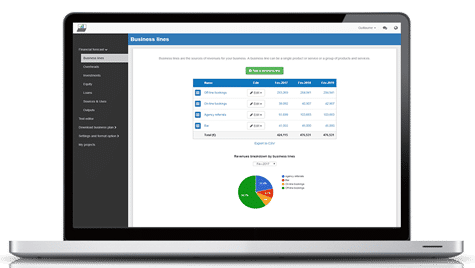How to create a financial forecast for a motorcycle store?
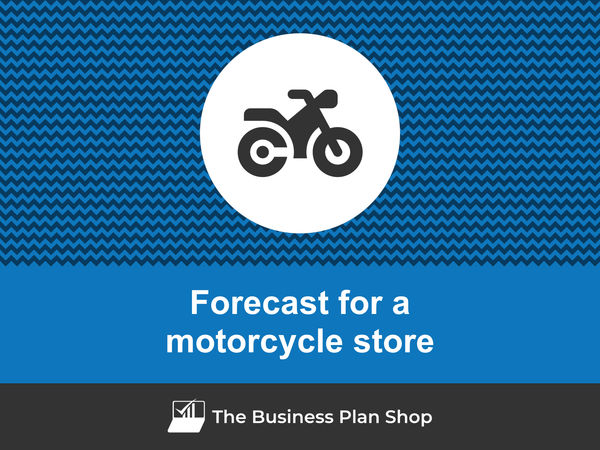
Creating a financial forecast for your motorcycle store, and ensuring it stays up to date, is the only way to maintain visibility on future cash flows.
This might sound complex, but with the right guidance and tools, creating an accurate financial forecast for your motorcycle store is not that hard.
In this guide, we'll cover everything from the main goal of a financial projection, the data you need as input, to the tables that compose it, and the tools that can help you build a forecast efficiently.
Without further ado, let us begin!
Why create and maintain a financial forecast for a motorcycle store?
The financial projections for your motorcycle store act as a financial blueprint to guide its growth with confidence and ensure its long-term financial viability.
To create them, you will need to look at your business in detail - from sales to operating costs and investments - to assess how much profit it can generate in the years to come and what will be the associated cash flows.
During challenging market conditions, maintaining an up-to-date financial forecast enables early detection of potential financial shortfalls, allowing for timely adjustments or securing financing before facing a cash crisis.
Your motorcycle store's financial forecast will also prove invaluable when seeking financing. Banks and investors will undoubtedly request a thorough examination of your financial figures, making precision and presentation essential.
Need a solid financial forecast?
The Business Plan Shop does the maths for you. Simply enter your revenues, costs and investments. Click save and our online tool builds a three-way forecast for you instantly.
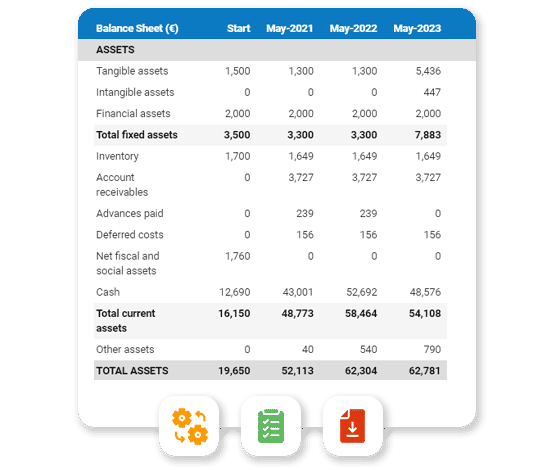
What information is used as input to build a motorcycle store financial forecast?
A motorcycle store's financial forecast needs to be built on the right foundation: your assumptions.
The data required to create your assumptions will depend on whether you are a new or existing motorcycle store.
If you are creating (or updating) the forecast of an existing motorcycle store, then your main inputs will be historical accounting data and operating metrics, and your team’s view on what to expect for the next three to five years.
If you are building financial projections for a new motorcycle store startup, you will need to rely on market research to form your go-to-market strategy and derive your sales forecast.
For a new venture, you will also need an itemised list of resources needed for the motorcycle store to operate, along with a list of equipment required to launch the venture (more on that below).
Now that you understand what is needed, let’s have a look at what elements will make up your motorcycle store's financial forecast.
The sales forecast for a motorcycle store
From experience, it usually makes sense to start your motorcycle store's financial projection with the revenues forecast.
The inputs used to forecast your sales will include the historical trading data of your motorcycle store (which can be used as a starting point for existing businesses) and the data collected in your market research (which both new ventures and existing businesses need to project their sales forward).
Your motorcycle store's sales forecast can be broken down into two key estimates:
- The average price
- The number of monthly transactions
To assess these variables accurately, you will need to consider the following factors:
- Economic conditions: Changes in the local or national economy can greatly impact the average price and number of transactions at your motorcycle store. For example, during a recession, people may be more likely to purchase lower-priced motorcycles, resulting in a decrease in your average price. On the other hand, during a period of economic growth, people may be more willing to splurge on high-end motorcycles, increasing your average price.
- Competitor pricing: The prices offered by your competitors can also affect your store's average price and number of transactions. If your competitors are consistently offering lower prices, you may need to adjust your prices to remain competitive, potentially decreasing your average price. Additionally, if your competitors are offering promotions or discounts, it may attract more customers to their store, resulting in a decrease in your number of transactions.
- Seasonal demand: The demand for motorcycles can vary depending on the season. For example, in colder climates, the demand for motorcycles may decrease during the winter months, resulting in a decrease in your number of transactions. On the other hand, in warmer climates, the demand for motorcycles may increase during the summer months, potentially increasing your number of transactions.
- Availability of new models: The release of new motorcycle models can also impact your average price and number of transactions. If a highly anticipated model is released, it may attract more customers to your store, potentially increasing your number of transactions. However, if the new model is priced significantly higher than previous models, it may also increase your average price.
- Changes in technology: Advancements in motorcycle technology can also affect your store's average price and number of transactions. For example, if new technologies make motorcycles more fuel-efficient or environmentally friendly, it may increase the demand for these types of motorcycles, potentially increasing your number of transactions. However, if these advancements also come with a higher price tag, it may also increase your average price.
Once you have a sales forecast in place, the next step will be to work on your overhead budget. Let’s have a look at that now.
Need inspiration for your business plan?
The Business Plan Shop has dozens of business plan templates that you can use to get a clear idea of what a complete business plan looks like.

The operating expenses for a motorcycle store
The next step is to estimate the costs you’ll have to incur to operate your motorcycle store.
These will vary based on where your business is located, and its overall size (level of sales, personnel, etc.).
But your motorcycle store's operating expenses should normally include the following items:
- Staff Costs: This includes salaries, benefits, and training for your employees. As a motorcycle store, you will need salespeople, mechanics, and possibly a store manager. You may also need to hire part-time or seasonal staff during peak seasons.
- Accountancy Fees: You may need to hire an accountant to handle your bookkeeping, tax preparation, and financial reporting. This is especially important if you are not familiar with accounting or if you have a complex business structure.
- Insurance Costs: You will need to purchase insurance to protect your store, inventory, and employees. This may include general liability insurance, property insurance, and workers' compensation insurance.
- Software Licenses: To manage your inventory, sales, and customer data, you may need to purchase software licenses for point-of-sale systems, inventory management software, and customer relationship management (CRM) software.
- Banking Fees: As a business owner, you will need a business bank account to manage your finances. This may include fees for monthly account maintenance, wire transfers, and transaction fees.
- Rent/Mortgage: If you are leasing or own a physical store location, you will need to pay rent or a mortgage. This expense can vary greatly depending on the location and size of your store.
- Utilities: You will need to pay for utilities such as electricity, water, and internet for your store. Depending on the size of your store and your location, these costs can add up.
- Marketing and Advertising: To attract customers to your store, you may need to invest in marketing and advertising. This can include digital marketing, print ads, and sponsoring local events.
- Inventory: As a motorcycle store, you will need to purchase inventory to sell to your customers. This may include motorcycles, spare parts, and accessories.
- Maintenance and Repairs: You will need to budget for regular maintenance and repairs for your store and equipment. This includes routine maintenance for your store, as well as repairs for your motorcycles and other equipment.
- Training and Development: To keep your employees up-to-date with the latest trends and technologies in the motorcycle industry, you may need to invest in training and development programs.
- Professional Memberships: Joining professional organizations and associations can provide networking opportunities and resources for your business. However, there may be membership fees associated with these organizations.
- Legal Fees: You may need to hire a lawyer for legal advice and assistance with contracts, lease agreements, and other legal matters related to your business.
- Office Supplies: To keep your store running smoothly, you will need to purchase office supplies such as paper, ink cartridges, and other essential items.
- Travel Expenses: If you attend trade shows or conferences, or if you need to visit suppliers or manufacturers, you may need to budget for travel expenses such as airfare, lodging, and meals.
This list is not exhaustive by any means, and will need to be tailored to your motorcycle store's specific circumstances.
What investments are needed to start or grow a motorcycle store?
Creating and expanding a motorcycle store also requires investments which you need to factor into your financial forecast.
Capital expenditures and initial working capital items for a motorcycle store could include elements such as:
- Motorcycles: This includes the purchase of new or used motorcycles for your inventory. It also includes any necessary repairs or maintenance to keep your motorcycles in good condition.
- Tools and Equipment: As a motorcycle store, you will need specific tools and equipment to service and repair motorcycles. This can include items such as tire changers, lifts, and diagnostic tools.
- Store Fixtures: Your store will need fixtures such as display cases, shelving, and wall racks to showcase your merchandise. These items may also need to be updated or replaced over time.
- Furniture and Decor: In addition to store fixtures, you may also need to purchase furniture and decor for your store. This can include items such as chairs, tables, and wall decorations.
- Computer Systems: In order to keep track of your inventory and process sales, you will need a computer system. This can include hardware such as computers and printers, as well as software for inventory and point-of-sale management.
Again, this list is not exhaustive and will need to be adjusted according to the circumstances of your motorcycle store.
Need a convincing business plan?
The Business Plan Shop makes it easy to create a financial forecast to assess the potential profitability of your projects, and write a business plan that’ll wow investors.
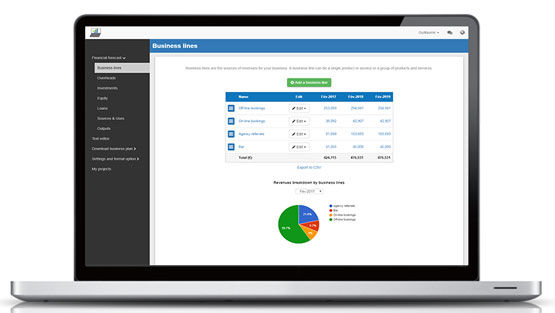
The financing plan of your motorcycle store
The next step in the creation of your financial forecast for your motorcycle store is to think about how you might finance your business.
You will have to assess how much capital will come from shareholders (equity) and how much can be secured through banks.
Bank loans will have to be modelled so that you can separate the interest expenses from the repayments of principal, and include all this data in your forecast.
Issuing share capital and obtaining a bank loan are two of the most common ways that entrepreneurs finance their businesses.
What tables compose the financial plan for a motorcycle store?
Now let's have a look at the main output tables of your motorcycle store's financial forecast.
The forecasted profit & loss statement
The profit & loss forecast gives you a clear picture of your business’ expected growth over the first three to five years, and whether it’s likely to be profitable or not.

A healthy motorcycle store's P&L statement should show:
- Sales growing at (minimum) or above (better) inflation
- Stable (minimum) or expanding (better) profit margins
- A healthy level of net profitability
This will of course depend on the stage of your business: numbers for an established motorcycle store will look different than for a startup.
The projected balance sheet
Your motorcycle store's projected balance sheet provides a snapshot of your business’s financial position at year-end.
It is composed of three types of elements: assets, liabilities and equity:
- Assets: represent what the business possesses including cash, equipment, and accounts receivable (money owed by clients).
- Liabilities: represent funds advanced to the business by lenders and other creditors. They include accounts payable (money owed to suppliers), taxes payable and loans from banks and financial institutions.
- Equity: is the combination of what has been invested by the business owners and the cumulative profits and losses generated by the business to date (which are called retained earnings). Equity is a proxy for the value of the owner's stake in the business.

The cash flow forecast
Your motorcycle store's cash flow forecast shows how much cash your business is expected to consume or generate in the years to come.

It is best practice to organise the cash flow forecast by nature to better explain where cash is used or generated by the motorcycle store:
- Operating cash flow: shows how much cash is generated by the operating activities
- Investing cash flow: shows how much will be invested in capital expenditure to maintain or expand the business
- Financing cash flow: shows if the business is raising new capital or repaying financiers (debt repayment, dividends)
Keeping an eye on (and regularly updating) your motorcycle store's cash flow forecast is key to ensuring that your business has sufficient liquidity to operate normally and to detect financing requirements as early as possible.
If you are trying to raise capital, you will normally be asked to provide a monthly cash flow forecast in your motorcycle store's financial plan - so that banks or investors can assess seasonal variation and ensure your business is appropriately capitalised.
Need a solid financial forecast?
The Business Plan Shop does the maths for you. Simply enter your revenues, costs and investments. Click save and our online tool builds a three-way forecast for you instantly.

Which tool should you use to create your motorcycle store's financial forecast?
Creating your motorcycle store's financial forecast may sound fairly daunting, but the good news is that there are several ways to go about it.
Using online financial forecasting software to build your motorcycle store's projections
The modern and easiest way is to use an online financial forecasting tool such as the one we offer at The Business Plan Shop.
There are several advantages to using specialised software:
- You can easily create your financial forecast by letting the software take care of the financial calculations for you without errors
- You have access to complete financial forecast templates
- You get a complete financial forecast ready to be sent to your bank or investors
- You can easily track your actual financial performance against your financial forecast, and recalibrate your forecast as the year goes by
- You can create scenarios to stress test your forecast's main assumptions
- You can easily update your forecast as time goes by to maintain visibility on future cash flows
- You have a friendly support team on standby to assist you when you are stuck
- It’s cost-efficient and much cheaper than using an accountant or consultant (see below)
If you are interested in this type of solution, you can try our projection software for free by signing up here.
Calling in a financial consultant or chartered accountant
Enlisting the help of a consultant or accountant is also a good way to obtain a professional motorcycle store financial forecast.
The downside of this solution is its cost. From experience, obtaining a simple financial forecast over three years (including a balance sheet, income statement, and cash flow statement) is likely to cost a minimum of £700 or $1,000.
The indicative cost above, is for a small business, and a forecast is done as a one-shot exercise. Using a consultant or accountant to track your actuals vs. forecast and to keep your financial projections up to date on a monthly or quarterly basis will cost a lot more.
If you opt for this solution, make sure your accountant has in-depth knowledge of your industry, so that they may challenge your figures and offer insights (as opposed to just taking your assumptions at face value to create the forecast).
Why not use a spreadsheet such as Excel or Google Sheets to build your motorcycle store's financial forecast?
You and your financial partners need numbers you can trust. Unless you have studied finance or accounting, creating a trustworthy and error-free motorcycle store financial forecast on a spreadsheet is likely to prove challenging.
Financial modelling is very technical by nature and requires a solid grasp of accounting principles to be done without errors. This means that using spreadsheet software like Excel or Google Sheets to create accurate financial forecasts is out of reach for most business owners.
Creating forecasts in Excel is also inefficient nowadays:
- Software has advanced to the point where forecasting can be done much faster and more accurately than manually on a spreadsheet.
- With artificial intelligence, the software is capable of detecting mistakes and helping decision-making.
Spreadsheets are versatile tools but they are not tailor-made for reporting. Importing your motorcycle store's accounting data in Excel to track actual vs. forecast is incredibly manual and tedious (and so is keeping forecasts up to date). It is much faster to use dedicated financial planning tools like The Business Plan Shop which are built specially for this.
Need a convincing business plan?
The Business Plan Shop makes it easy to create a financial forecast to assess the potential profitability of your projects, and write a business plan that’ll wow investors.

Use our financial projection templates for inspiration
The Business Plan Shop has dozens of financial forecast templates available.
Our examples contain a complete business plan with a financial forecast and a written presentation of the company, the team, the strategy, and the medium-term objectives.
Whether you are just starting out or already have your own motorcycle store, looking at our financial forecast template is a good way to:
- Understand what a complete business plan should look like
- Understand how you should model financial items for your motorcycle store
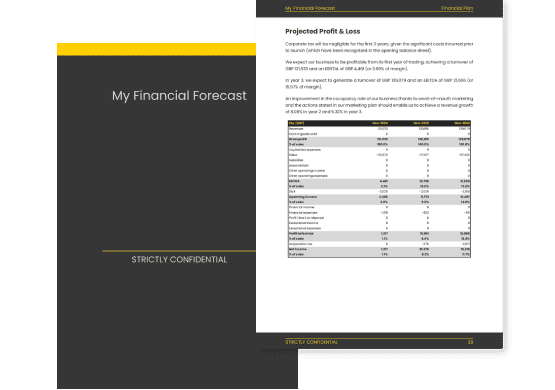
Takeaways
- Having a financial forecast enables you to visualise the expected growth, profitability, and cash generation for your business over the next three to five years.
- Tracking actuals vs. forecast and keeping your financial projections up-to-date is the only way to get a view on what your motorcycle store future cash flows may look like.
- Using financial forecasting software is the mordern and easy way to create and maintain your forecasts.
This is the end of our guide on how to build the financial forecast for a motorcycle store, we hope you found it useful. Don't hesitate to contact us if you want to share your feedback or have any questions.
Need inspiration for your business plan?
The Business Plan Shop has dozens of business plan templates that you can use to get a clear idea of what a complete business plan looks like.

Also on The Business Plan Shop
Know someone who owns or is thinking of starting a motorcycle store? Share our forecasting guide with them!

